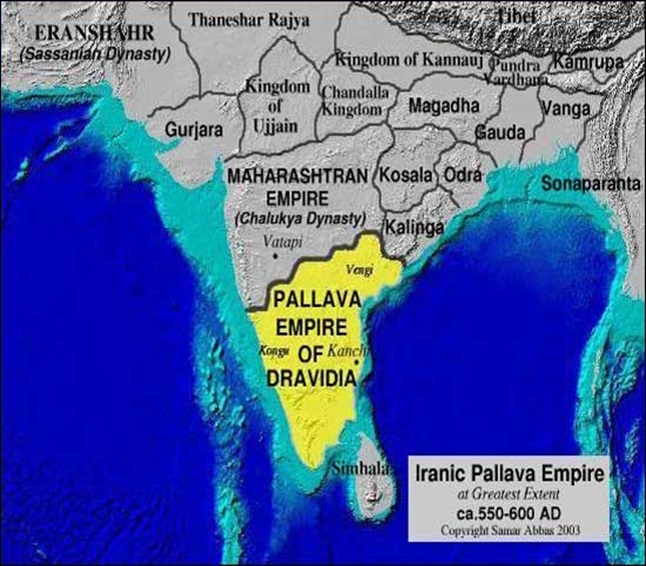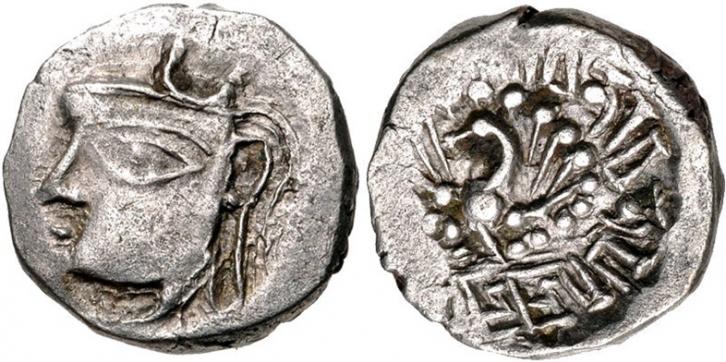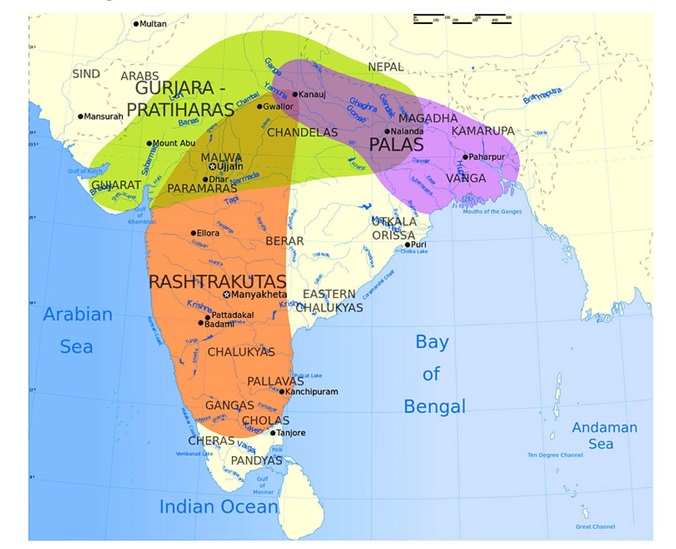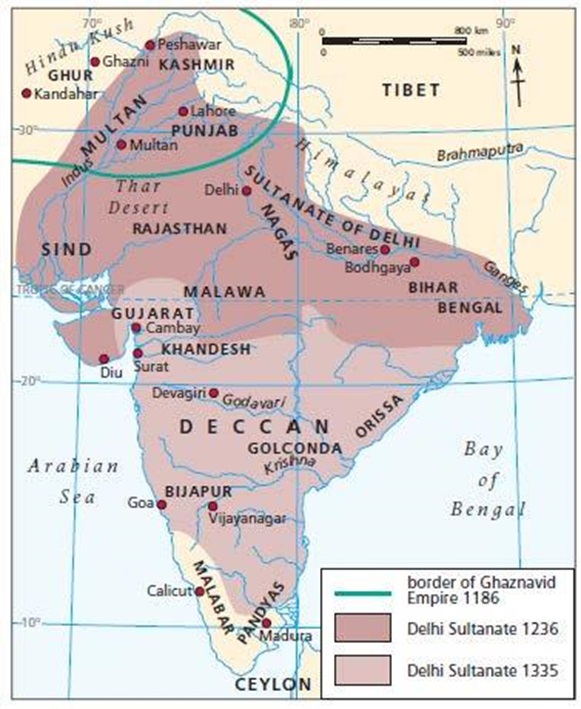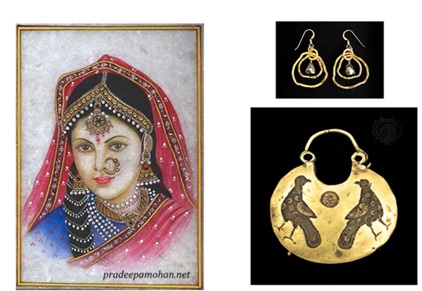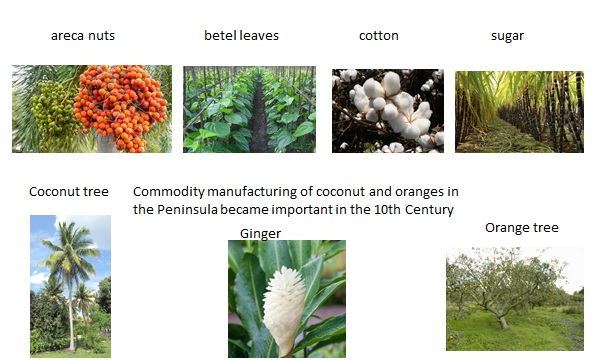India Hindu Period (500CE to 1500CE) – Geography and People
Lives of people living in southern India continued at the same pace as before, but the lives of people living in northern and western India were impacted drastically during the second half of this period because of Islamic invasions and the establishment of Islamic rule.
Figure 1. A snapshot of different empires and kingdoms which flourished in India 600AD.
Harshavardhan consolidated the northern states into his empire in the 606-647 CE period. The Chinese traveler Xuanzang visited the court and wrote a very favorable account of him. After the death of Emperor Harshavardhana, his empire disintegrated. Another empire was established by Mihira Bhoja in the early 9th century CE. At its height, Bhoja's empire extended to Narmada River in the South, Sutlej River in the northwest, and up to Bengal in the east. Under Bhoja and his successor Mahendrapala (reigned c. 890–910), the Pratihara empire reached its peak of prosperity and power. Temple architecture exhibited by the majestic Kailas temple at Ellora and exquisite beauty of Chandella Siva Temple ta Khajuraho symbolizes of this period. Indian architecture flourished during the entire period.
Figure 2. Coins of Harshavardhana (Wikipedia).
Figure 3. Rashtrakutas, Gurjara-Pratihara and Pala Empires – 8th to 11th century CE.
Buddhism declined after the rule of Harshvardhana. Its disappearance from India was hastened by the growing unpopularity of Tantric practices. The sweeping revival movement of the Age was led by Shankaracharya, the prophet. Shankaracharya preached Monism. He purged many religious beliefs of their gross misuse. Sanskrit was the language of the cultured, spoken and understood among the educated throughout the count.
The first Tuk invasion in 1000CE ended in the conquest of Sindh.. Invasions by Mahmud of Ghazni and Mahammad Ghauri followed the pattern of looting and destruction. The horrors of barbarian invasions, fired with the fanatic zeal for demolishing temples and idols, born of the crusading spirit of Islam, were let loose. In 1206 CE, Qutab-ud-din Aibak established the Turkish Sultanate of India first at Lahore and then at Delhi. Will Durant, in his “Story of Civilization†aptly says: “The Mohammedan conquest of India is probably the bloodiest story in history.â€
Figure 4. Islamic invasion to India 1000CE to 1200CE
The invading Turks began to look down on the people from whom most of its members had come, as infidels to be despised and converted or killed. The intrusion of Islam and its existence as a separate unit in India introduced for the first time the generic name Hindu. The massive repositories of knowledge in the libraries were burnt down along with the resident monks.
Economic conditions in the areas of India where the Turkish armies did not operate were good. Agriculture yielded bountiful harvests, industries flourished, internal trade and maritime commerce was brisk and profitable. Important shrines and universities were richly endowed. Men and women, simply dressed but richly ornamented, moved about freely. Fairs and feasts were held in plenty. Flowers were in general use as personal ornaments. Dance, drama and music, both vocal and instrumental, were very popular. Marco Polo was astonished at the prosperity in Gujarat. Bharuch and Cambay, the two ports in Gujarat carried on a large international trade. A brisk trade was carried on with Sumatra and Java. Malabar also had international center of trade, visited by ships from the Persian Gulf, the Arabian Sea as also from South China.
Figure 5. Jewelry and ornaments, 12 century CE.
Figure 6. Agricultural export, 10th century CE.
At the end of 12th century, the Hindu kingdom of Champa (Indo China) under Jayavarman VIII, extended from the Bay of Bengal on one side to South China Sea on the other. Java also continued to be a powerful Hindu kingdom till the 15th century, when it was conquered by Muslims. The empire of Kambuja (Cambodia) reached its zenith in the 11th century, when Suryavarman II built the great temple of Angkor Vat, reckoned as one of the wonders of the world.
References:
Bhartiya Vidya Bhavan, "The History and Culture of the Indian People, The Age of Imperial Kanauj", Volume 4, 1989.
Bhartiya Vidya Bhavan, "The History and Culture of the Indian People, The Struggle for Empire" Volume 5, 1989.
Will Durant, "The Story of Civilization I Our Oriental Heritage", Simon and Schuster, 1954.
Romila Thapar, "The History of Indiaâ€, Volumes I & II, Penguin books (reprint), 1990.
___________________________________________________________________________________________
Dr. Hemendra Acharya is a co-leader in Geography and People track in the project on "Evolution of Indian Culture: Pre-history to 1947AD"
More information and updates on the project are available at https://www.facebook.com/Evolution-of-Indian-Culture-An-IDC-Project-107749391111922
More information on India Discovery Center is available at https://www.indiadiscoverycenter.org
(c) Copyright 2021 India Discovery Center, Inc. All rights reserved.

